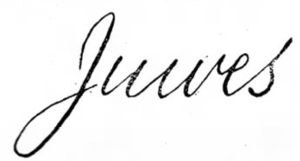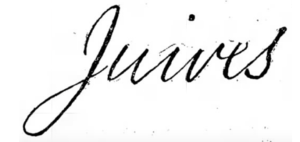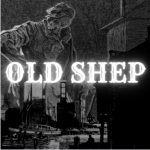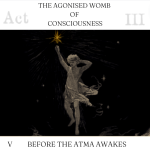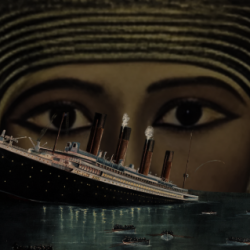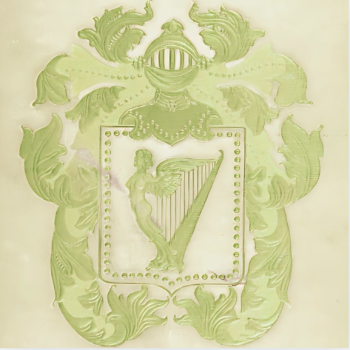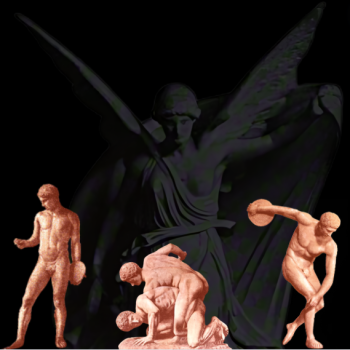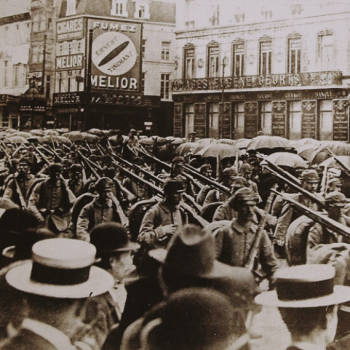THE ONE WHO THINKS HE KNOWS
ACT III.
IV.
⸻
The tall pale man with lupine eyes sat on the edge of his bed in London Hospital. He concluded his story with the same emotionless rhythm as when he began. It was unsettling. W.T. Stead was beginning to share in the belief of the police that this man the veritable Jack the Ripper. Stead, of course, kept this to himself.[1]
“I entered,” said the man. “Lord Lytton was standing in the middle of the sacred pentagon, which he had drawn upon the floor with red chalk, and holding in his extended right arm the baguette, which was pointed towards me. Standing thus, he asked me if I had duly considered the matter and had decided to enter upon the course. I replied that my mind was made up. He then and there administered to me the oaths of a neophyte of the Hermetic lodge of Alexandria—the oaths of obedience and secrecy. It is self-evident that any further account of my experiences with Lord Lytton, or in Hermetic circles, is impossible.” [2]
“Naturally,” Stead replied.
Before leaving, the editor of The Pall Mall Gazette told his guest-contributor that he expected to have the article published in the December 1, edition of the paper.
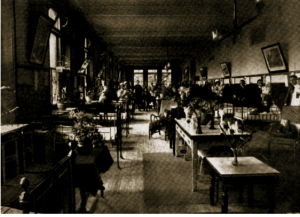
Ward in London Hospital.[3]
Stead existed the hospital and crossed the street to the Mile End Railway Station. “It would be odd if the mystical lore of the author of Zanoni were to help to unearth Jack the Ripper,” he thought.[4]
~
The following evening W.Q. Judge and a gathering of Theosophists were in the parlors of Lansdowne Road discussing his recent trip to Ireland, and the prospects of the Dublin Lodge.
“Ireland’s real name signifies, ‘the Isle of Destiny,’” said Judge. “She has long been a thorn in England’s side, and has furnished great men, poets, and warriors, to all western peoples. Perhaps now some great exponent of Theosophy will arise on this island.”[5]
“Madame,” said Yeats, “you did tell me ‘that the power of England would not outlive the century.’”[6]
“The Master never deceives me, Mr. Yeats,” said Blavatsky, coolly looking at the poet through the barrel of her cigarette.
“That’s a queer place, Judge—that Ireland,” Blavatsky continued. “It is packed full of a singular class of elementals,” she said, now looking at Judge. “By Jove! I see they even have emigrated in quite large numbers. Sometimes one, quite by accident, rouses up some ancient system—say from Egypt. That is the explanation of that singular astral noise which you said reminded you of a ‘sistrum being shaken.’”[7]
“Once upon a time the Celtic nations worshiped gods of the light,” said Yeats. “In Ireland they are called Tuatha-de-Danann, and they correspond to Jupiter and his fellows. The gods of the great darkness correspond to the Satumian Titans. Among the ‘sociable fairies’ are many of the light gods—perhaps, someday, we may learn to look for the dark gods among the solitary fairies. We can trace the Pooka, for instance, to that mysterious deity of decay. The Pooka is certainly no bright Tuath-de-Danan—he seems to be of the family of the nightmare, and he most likely never appeared in human form. On November Eve, the first night of winter according to the old Gaelic reckoning, the fairies are very gloomy. They dance with ghosts in their green raths, and the Pooka has power.”[8]
“The Ripper…” whispered one of the ladies in the room.[9]
That is all it tool for the room to buzz with talk of the Whitechapel murders.
“English folk are fond of maintaining the superiority of their national morals as contrasted with those of our Continental neighbors across the seas,” said Blavatsky. “Yet had one of the latter been strolling down a thoroughfare of one of our large seaside resorts but a few days ago, he might have been inclined to doubt it. In a large shop an alluring tray of boys’ knives was exhibited and ticketed as ‘Jack Rippers knives!’ Meanwhile, in an adjacent street, a merry gang of children were playing at ‘Ripper,’ jumping one over the other and knocking them down—a true rehearsal of the felonious act.”[10]
“I notice that the English women are afraid to walk abroad,” said Bhaskaranand Saraswati. “It makes me think of the origin of the habit of our women of wearing veils and being secluded because of the Mohammedans, who, in their eyes, were so many fiends like this ‘Jack the Ripper.’”
There was silence in the room.
“But now this old habit is fading out in places,” added Saraswati. “In Southern India, veils are not worn, and women walk freely about, for of late years a greater confidence has arisen that the laws and rights of the people will be respected.”[11]
“Does anyone have the Pall Mall Gazette article?” asked one in the group. “Stead says the contributor in question, is an occultist of some experience who studied necromancy under the late Lord Lytton in Alexandria when he was a lad of eighteen.”[12]
Arch Keightley produced the clipping from his coat pocket. “Miss Cremers, would you care to read it?”
Earlier that day Vittoria Cremers walked in on Blavatsky seated at her card-table with a newspaper spread out before her. Arch and Bert were hovering above her like clouds and raining a torrent of inquiry.[13]
“Certainly,” said Vittoria, grabbing the clipping.[14] “’The Whitechapel Demon’s Nationality: And Why He Committed The Murders,’ by ‘One Who Thinks He Knows.’”:
In calmly reviewing the whole chain of facts connected with these daring and bloodthirsty atrocities, the first thing which strikes one is the fact that the murderer was kind enough to (so to speak) leave his card with the Mitre-Square victim. But this most important clue to his identity, which “he who runs may read,” seems to have baffled the combined intellects of all grades of police. This admits of no question, because we find in all the journals a note from Sir C. Warren to the effect that “no language or dialogue is known in which the word ‘Jews’ is spelt ‘Juwes.’”
O! Most sapient conclusion! Let us see what we can make of the word.
It will be remembered that a chalk inscription (which it is not denied was written by the murderer) was found in the wall in Mitre-square, just above the body of the murdered woman. It ran as follows—“The Juwes are the men who will not be blamed for nothing,” and was evidently to throw suspicion on the Jews. This writing was only seen by the police by means of artificial light and was unfortunately obliterated by them before daylight. Hinc illae lacrimae! (That is what those tears were for.)
Why did the murderer spell the word Jews “Juwes?” Was it that he was an uneducated Englishman who did not know how to spell the word; was he in reality an ignorant Jew, reckless of consequences and glorifying in his deeds; or was he a foreigner, well accustomed to the English language, but who in a tremendous hurry of the moment unconsciously wrote the fatal word in his native tongue?
The answers to these three queries, on which the whole matter rests, are easy. Juwes is a much too difficult word for an uneducated man to evolve on the spur of the moment, as any philologist will allow. Any ignorant Jew capable of spelling the rest of the sentence as correctly as he did, would know, certainly, how to spell the name of his own people. Therefore, only the last proposition remains, which we shall now show, it is the most conclusive manner, to be the truth.
To critically examine an inscription of this kind, the first thing we naturally do is not to rest satisfied with reading it in print, but to make, as nearly as we can, a facsimile of it in script, thus:—
Inspection at once shows us, them, that a dot has been overlooked by the constable who copied it, as might easily occur, especially if it were placed at some distance, after the manner of foreigners.
Therefore we place a dot above the third upstroke in the word, and we find it to be Juives, which is the French word for Jews.
Strictly and grammatically speaking, of course, it is the feminine form of Juifs and means “Jewesses.” But in practice it will be found that (Frenchmen being notoriously the worst linguists in the world) most Frenchmen who are not either littérateurs or men of science are very inaccurate as to their genders. And almost all the ouvrier and a large majority of the bourgeois class use the feminine where the word should be masculine. Even the Emperor Napoleon III was a sinner in this respect, as his voluminous correspondences amply show.
Therefore, it is evident that the native language—or, to be more accurate, the language in which this murderer thinks—is French.
It may be here argued that both Swiss and Belgians make French almost their mother-tongue; but Flemish is the natural and usual vehicle for the latter, while the idiosyncrasy of both those nationalities is adverse to this class of crime.
On the contrary, in France, the murdering of prostitutes has long been practiced, and has been considered to be almost peculiarly a French crime.
Again, the grammatical construction of the sentence under examination is distinctly French in two points—First, in the double negative contained; and secondly, in the employment of the definite article before the second noun. An Englishman or an American would have said, “The Jews are men who, &c.” But the murderer followed his native idiom “Les Juifs sont des hommes” in his thoughts, and when putting it into English rendered des hommes “the men.”
Again, neither Belgians nor Swiss entertain animosity to the Jews, whereas the hatred of the French proletarian to them is notorious.
The ground for research thus being cleared and narrowed, the next question is, what is his motive? Speculation has been rife, theories are many; almost every man one meets, who is competent to form an opinion, having a different one.
And in endeavoring to sift a mystery like this one cannot afford to throw aside any theory, however extravagant, without careful examination, because the truth might, after all, lie in the most unlikely one.
There seems to be no doubt that the murderer, whether mad or not, had a distinct motive in his mutilations; but one possible theory of that motive has never been suggested. In the nineteenth century, with all its enlightenment, it would seem absurd, were it not the superstition dies hard, and some of its votaries do undoubtedly to this day practice unholy rites.
Now, in one of the books by the great modern occultist who wrote under the nom de plume of “Eliphaz Levy,” “Le Dogme et Rituel de la Haute Magie,” we find the most elaborate directions for working magical spells of all kinds. The second volume has a chapter on Necromancy or black magic, which the author justly denounces as a profanation. Black magic employs the agencies of evil spirits and demons, instead of beneficent spirits directed by the adepts of la haute magie. At the same time he gives the clearest and fullest details of the necessary steps for evocation by this means, and it is in the list of substances prescribed as absolutely necessary to success that we find the link which joins modern French necromancy with the quest of the East-end murderer. These substances are in themselves horrible, and difficult to procure. They can only be obtained by means of the most appealing crimes, of which murder and mutilation of the dead are the least heinous. Among them are strips of the skin of a suicide, nails from a murderer’s gallows, candles made from human fat, the head of a black cat which has been fed forty days on human flesh, the horns of a goat which has been made the instrument of an infamous and capital crime, and a preparation made from a certain portion of the body of a harlot. This last point is insisted upon as essential; and it was this extraordinary fact that first drew my attention to the possible connection of the murderer with the black art.
Further, in the practice of evocation the sacrifice of human victims was a necessary part of the process, and the profanation of the cross and other emblems usually considered sacred was also enjoined. In this connection it will be well to remember one most extraordinary and unparalleled circumstance in the commission of the Whitechapel murders, and a thing which could not by any possibility have been brought about fortuitously. Leaving out the last murder, committed indoors, which was most probably not committed by the fiend of whom we speak, we find that the sites of the murders, six in number, form a perfect cross. That is to say, a line ruled from No. 3 to No. 6., on a map having the murder sites marked and numbered, passes exactly through Nos. 1 and 2, while the cross arms are accurately formed by a line from No. 4 to 5.
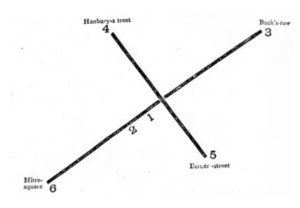
The seventh, or Dorset-street murder, does not fall within either of these lines, and there is nothing to connect it with the others except the fact of the mutilations. But the mutilations in this latter case were evidently not made by anyone having the practical knowledge of the knife and the position of the respective organs which was exhibited in the other six cases, and also in the mutilated trunk found in the new police-buildings, which was probably the first of the series of murders, and was committed somewhere on the lines of a cross, the body being removed at the time. Did the murderer, then, designing to offer the mystic number of seven human sacrifices in the form of a cross—a form which he intended to profane—deliberately pick out beforehand on a map the places in which he would offer them to his infernal deity of murder? If not, surely these six coincidences (?) are the most marvelous event of our time.
To those persons to whom this theory may seem somewhat far-fetched, we would merely remark that the French book referred to was only published a few years ago; that thousands of copies were sold; that societies have been formed for the study and practice of its teachings and philosophy; and, finally, that within the last twelve months an English edition has been issued. In all things history repeats itself, and superstitions of yesterday become the creeds of today.[15]
← →
THE AGONIZED WOMB OF CONSCIOUSNESS SECTIONS: “ACT III”
I. TOWER HAMLETS.
III. OCCULTISM OF SOUTHERN INDIA.
IV. THE ONE WHO THINKS HE KNOWS.
SOURCES:
[1] Stead, W.T. “Our Gallery Of Borderlanders: A Modern Magician: An Autobiography.” Borderland. Vol. III, No. 2. (April 1896): 139-156.
[2] Ibid.
[3] “The Needs and Deeds of the London Hospital.” The Sketch. Vol. XXII, No. 278. (May 25, 1898): 193-194.
[4] “Tittle Tattle for The Tea Table.” The Pall Mall Gazette. (London, England) December 3, 1888.
[5] Judge, W.Q. “Theosophical Activities.” The Path. Vol. I, No. 3 (June 1886): 95-96.
[6] Dunlop, Daniel Nicol. “Interview With Mr. W.B. Yeats.” The Irish Theosophist Vol. II, No. 2. (November 15, 1893): 147-149.
[7] “Conversations On Occultism With H.P.B.” The Path. Vol. IX, No. 1. (April, 1894): 17-21
[8] Yeats, William Butler. “Irish Fairies, Ghosts, Witches, Etc.” Lucifer. Vol. III, No. 17. (January 15, 1889): 399-404.
[9] Ariadne. “Children Allowed To Train Themselves For Murder.” Lucifer Vol. III, No. 16. (December 15, 1888): 341-342.
[10] “Children Allowed To Train Themselves For Murder.” Lucifer. Vol. III, No. 16 (December 15, 1888): 341-342.
[11] Saraswati, Bhaskara Nand. “Some Customs Of Aryavarta.” Oriental Department Papers. No. I. (January 1891): 1-9.
[12] “Tittle Tattle for The Tea Table.” The Pall Mall Gazette. (London, England) December 3, 1888.
[13] Harris, Melvin. The True Face Of Jack The Ripper. Michael O’Mara Books Limited. London, England. (1994): 46-47.
[14] Dimonialis, Spiro. Jack The Ripper And Black Magic. McFarland & Company, Inc. Jefferson, North Carolina. (2011): 101-102.
[15] One Who Thinks He Knows. “The Whitechapel Demon’s Nationality: And Why He Committed The Murders.” The Pall Mall Gazette (London, England) December 1, 1888.


